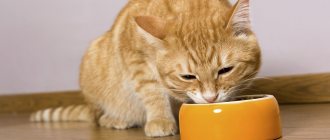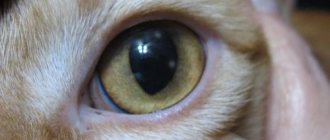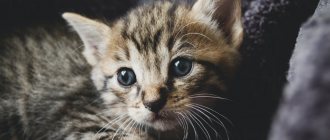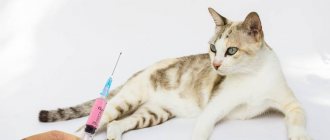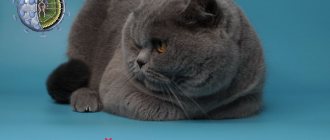If you notice that your cat is bleeding from the vulva, it is understandable that you are worried, as this sign indicates that something is wrong and you are likely facing a health problem.
Cystitis, uterine infections, trauma or tumors may be some of the reasons why your cat is bleeding, but what should we do in these cases? The first step is to immediately contact a veterinary center, since some pathologies that can cause these symptoms can be fatal.
In this article, we will talk about the causes of bleeding in cats, explaining the main reasons why a cat is bleeding and how to treat it. Everything you need to know next, but don't forget: a visit to the vet is essential.
Bloody discharge due to urolithiasis
Urolithiasis (urolithiasis) is a disease accompanied by the formation and deposition of urinary stones or sand in the organs of the urinary system.
Most often, the development of urolithiasis is provoked by an unbalanced diet, when the animal is fed too salty or fatty foods, table scraps, or the pet is kept exclusively on dry food.
Urolithiasis can progress very quickly and often leads to the death of the animal , so if a problem is detected, you should never self-medicate. To minimize your pet's suffering before visiting the veterinarian, you can give him Baralgin M (solution). Dosage: 0.05 mg per 1 kg of animal body weight.
Baralgin M is contraindicated for use if the pet is less than six months old.
Signs of ICD
The development of the disease is indicated by the following symptoms:
- presence of blood in the urine;
- restless behavior of the animal;
- lack of appetite;
- frequent urge to urinate, accompanied by a plaintive meow;
- small amount of urine when urinating;
- apathy.
If you suspect urolithiasis, you should immediately contact a veterinarian. Surgery may be required.
Prevention
As a preventive measure, it is recommended to adjust the animal’s diet. There are some general rules that must be followed when organizing a cat's diet :
- It is necessary to minimize the share of dry industrial food of economy class, because they contain a large amount of salt, which provokes the development of urolithiasis.
- It is recommended to exclude fatty natural products from the diet, including table food.
- Food should contain a minimum amount of sugar, salt, phosphorus and magnesium.
- Your cat should always have fresh water freely available.
The risk of developing the disease can also be reduced by encouraging an active pet lifestyle.
Presence of stones in the urinary system
This pathology is often found among domestic animals.
Most often it affects males. However, sometimes stones in the organs of the urinary system are found in females. The exact reasons for the formation of stones have not yet been identified. However, experts say that abuse of dry food, deficiency of vitamin A and fluid in the diet, excess weight, gastrointestinal diseases and poor heredity can provoke the disease. Stones are one possible explanation for why your cat is bleeding.
Vaginitis
Vaginitis is an inflammation of the vaginal mucosa.
Many owners mistake vaginitis for estrus due to the fact that cats suffering from this disease are attracted to males. The cause of the disease is most often an unsuccessful mating.
Symptoms of the disease:
- bleeding from the vagina;
- frequent urination;
- swelling of the vulva.
If you suspect vaginitis, it is recommended to wash your cat's vagina with a chamomile solution.
If this bleeding does not stop, you should contact a specialist as soon as possible.
Symptoms
Blood in the urine is not the only thing the owner needs to pay attention to. There is also increased frequency and difficulty in urination or delayed excretion, the animal begins to urinate not in the tray, but in prohibited places, and experiences constant anxiety in the genital area. The general physical condition worsens, the cat becomes lethargic and drowsy. His appetite decreases and he refuses his favorite treats.
Apathy towards everything also appears, the pet stops playing and becomes less social. Meows often, approaches the owner, and rushes around the apartment.
If the appearance of hematuria is influenced by an infection, the temperature may rise.
Pyometra
Among the most common diseases of cats with bloody discharge is pyometra, a form of purulent endometritis in which pus accumulates in the uterine cavity. The disease is most often provoked by rash actions of the owners themselves, namely:
- abuse of hormonal drugs during estrus;
- uncontrolled mating;
- infection in the vagina during childbirth.
There are two types of pyometra:
- Open form - blood clots come out of the vagina. The cat licks itself frequently, approximately every 15-20 minutes. The animal's temperature rises, the cat often drinks water.
- Closed form - no discharge visible, because blood accumulates in the uterine cavity. Symptoms of the closed form of pyometra: enlarged, tight abdomen, frequent urination, apathy, rapid breathing.
Of these two forms, the second poses the greatest threat to health, because. excessive accumulation of pus in the uterus can lead to the death of the animal.
Mr. Cat explains: 5 rules for collecting urine
This is the main thing you need to know when collecting urine so that the analysis is most accurate:
- Prepare a cat litter box for collection. Initially disinfect and wash.
- Do not fill it with fillers.
- If the cat refuses to go to an empty tray, you can buy special mixtures in stores that are similar to fillers for collecting tests.
- After the animal has done its business, you need to pour the contents of the tray into a special container for collecting samples.
- Be sure to submit for analysis within 2-3 hours.
Discharge after pregnancy
The presence of bloody discharge in a pregnant cat is completely normal when it is presented as transparent, homogeneous, odorless clots.
However, prolonged discharge of purulent-bloody discharge with a greenish tint after birth indicates possible inflammation of the animal’s genital organs.
It often happens that the fetus gets stuck in the cat's womb, or the placenta for some reason does not come out of the uterus, as a result of which the process of rotting begins. In both cases, surgical removal of the foreign object will be required, because prolonged decomposition inside the animal's body can lead to intoxication of the pet.
Sometimes bloody discharge during the postpartum period may be just remnants of the placenta. Usually the placenta is completely expelled from the uterus within 3 hours after birth, and the number of membranes should correspond to the number of kittens. In this case, surgical intervention is not required.
How can you tell if an animal is unhealthy?
The phenomenon discussed in the article does not always indicate the presence of pathology. However, the presence of the disease may be indicated by the following accompanying symptoms:
- Reducing the pet's activity.
- Cat's refusal to eat.
- Frequent, infrequent or difficult urine output.
- Licking the perineal area.
- Heat.
- Increased heart rate, breathing problems.
If such signs occur, you urgently need to show the animal to a specialist who will carry out the necessary diagnostics. Examination using ultrasound and x-rays, laboratory tests of biological material will help determine what is causing the appearance of bloody discharge. If you consult a doctor in a timely manner, your pet can usually be cured.
After mating
Bloody discharge from the loop may appear in a cat after mating in the event of resorption of the fetus, which can occur at any stage of pregnancy. In most cases, the animal’s body independently copes with the problem , expelling the dead fetuses from the womb, but they can also remain in the uterus for quite a long time.
As a result, fruit rot begins, which can lead to inflammation of the cat’s genitals and blood poisoning. Resorption of the fruit is accompanied by bleeding with pus and mucus. Blood clots have a rather pungent odor.
A possible cause of bleeding after mating can also be an ectopic pregnancy. In this case, urgent assistance from a veterinarian is necessary—delayed surgical intervention can lead to the death of the pet.
What you can encounter and what the owner should be afraid of
To begin with, urine is the fluid that is excreted from the body as a result of the work of the kidneys, ureter and bladder. Along with it, various toxins, micro- and macroelements go away. Normally, it should be transparent or light yellow.
Diuresis in a healthy pet is 1-2 ml/kg/h. A minimum of 1 ml should be released.
For example, a pet weighs 4 kg, let’s calculate (1 ml x 4 kg x 24 hours = 96 ml), therefore, it should release approximately 96 ml per day.
Care, maintenance and treatment of your pet
In order for treatment measures to bring positive results more quickly, owners need to provide the cat with proper care:
- Provide a secluded place for the animal, put a disposable sheet on the bed and change it regularly when it gets dirty.
- The room where the sick cat is located must be warm and free of drafts, and it must be ventilated regularly.
- During treatment, it is forbidden to let your pet go outside; its communication with other pets should be limited.
- The cat must have constant access to drinking water. If the animal refuses to drink or is too weak, you need to give it water yourself using a syringe, after removing the needle.
- During the illness, the animal should receive nutritious and easily digestible food. These can be meat broths, to which chopped meat, fermented milk products, cereals and vegetables are added in small quantities. On the advice of a veterinarian, you can purchase special medicated food so that the animal gains strength faster.
To protect your pet from diseases that lead to bleeding, you must adhere to the following preventive measures:
- If the cat is not intended for breeding, it makes sense to sterilize the pet. This will protect her from many diseases that occur in the genitourinary system. After the procedure, the cat should be regularly shown to the veterinarian for an ultrasound, this will help to better monitor the animal’s health.
- Get all necessary vaccinations and antihelminthic treatment in a timely manner to maintain the body's defenses.
- For mating, choose a healthy male cat; the owners of the male must document this.
- When giving birth to a cat, use sterile consumables and thoroughly treat your hands with antiseptics.
- If any unusual discharge occurs, you should take your cat to the veterinarian as soon as possible.
The measures described above will help not only prevent the development of the disease, but also, if necessary, show the cat to a specialist as soon as possible without wasting time.
Bloody discharge accompanied by a significant deterioration in the animal’s condition is a formidable sign indicating the development of severe pathology. There is no need to try to find the cause on your own, but take the cat to the veterinary clinic as soon as possible for examination and treatment.
Diagnostics
To conduct a quality diagnosis, the owner must contact a professional veterinarian. Why is diagnosis by a doctor important:
- He will make an accurate diagnosis based on the possible causes of the disease. The owner can hardly identify the causes for sure, or does not search for the causes at all and buys medications in accordance with the symptoms. But one symptom can indicate several diseases at once.
- Depending on the age, character, weight, breed, causes and stage of the disease, the veterinarian prescribes treatment. Complex diseases often require not just some medications, diets and observation, but step-by-step treatment in different ways. It is not uncommon for treatment to require surgery.
Brown discharge from a cat's eyes
Independent actions may turn out to be wrong and cause more harm to the animal.
Note! Observation by a specialist is the most reliable way to cure an animal without complications or death in the shortest possible time.
Diagnosis is carried out through examinations, tests, ultrasound and the use of special medical equipment to examine internal organs. Continuous specialist supervision may be required.
Diagnosis of a pet
Diagnostics reveals more causes and problems of the body at more serious stages, but this does not mean that when a disease occurs, you need to wait until the pet becomes very ill. The more serious the stage, the longer, more difficult and more expensive the treatment, and the chances of fully restoring health become less.
Causes of hemorrhages
Internal bleeding may occur for the following reasons:
- Mechanical injuries.
- Entry of a foreign object into the respiratory tract.
- Ingestion of sharp objects by a cat, including fish or tubular bones.
- The rectum can be injured by hard feces.
- Neoplasms. The tumor may ooze slowly or rupture and cause severe bleeding. In some cases, it grows into a blood vessel, destroying it.
- Coagulopathies are blood clotting disorders. There are several reasons for their appearance, one of the common ones is poisoning with rat poison. Blood diseases, jaundice, and sepsis are also possible.
- Uterine bleeding can occur due to birth injuries, remaining placenta, or even a dead fetus. Possible tumors and inflammatory processes caused by infection, a large number of empty heats, or drugs to prevent them.
- Ulcers of the stomach and esophagus. Most often they manifest themselves by vomiting. In the first case, the blood will be dark and coagulated, in the second - scarlet.
- Infestation with parasites.
- Hypertension. Pressure above 160 over 100 can cause nosebleeds. Usually accompanied by irritability and impaired coordination of movements.
My relatives' Persian cat had a nosebleed once. The cause turned out to be inflammation of the tooth, but given Malkin’s advanced age, the veterinarian advised measuring his blood pressure at least once every six months by placing the cuff of an ordinary human tonometer on his paw or the base of his tail. It turns out that hypertension is quite common in older cats and can lead to serious complications. According to the same specialist, such measurements are best carried out at home - in a veterinary hospital, animals are nervous, so the results are almost certainly inaccurate. Now I also measure my Siberian daughter’s blood pressure every few months - she’s still young, but caution won’t hurt. As a rule, Irma endures the procedure with some surprise, but calmly.
We recommend reading: Wet food for cats: review and reviews from veterinarians
